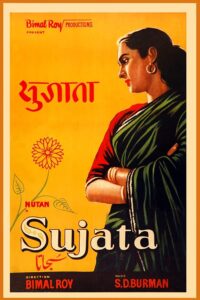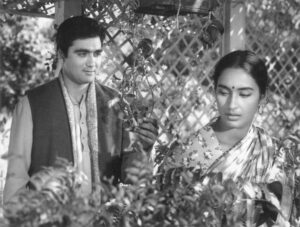1959 New Delhi, India
Nutan Lugani
1952
New Delhi India
Interviewed on 9 February 2023
by Adhya Sharma

The first movie I remember watching was Sujata. Have you heard of it? I watched it in Delhi in 1959. I was born in 1952, so I was only seven years old when I watched it. I remember everything about the movie – each and every scene. In fact, it left such a strong impression on me that I changed my name because of it!
I had been named Sumedha at birth. However, after watching the film, I wept and demanded my father name me after the actress who played the leading role: Nutan. He eventually agreed, and so, when I re-enrolled in school the following year, my name was registered as Nutan.
The film resonated with me because it was a humane tale about an orphaned girl named Sujata, who is from the lowest caste – an “untouchable.” You know how there is a complex history related to racial discrimination in America? Well, in India, we had the issue of the caste system. Though we had already gained Independence from the British about a decade ago at this point, the issue of untouchability unfortunately persisted. The Mahatma [Gandhi] had tried hard to make the caste system disappear, but it lingered like a ghost.
In the film, Sujata has lost her parents in an epidemic. So, a wealthy, upper-caste family, for whom her father had worked as a laborer, is forced to take her in. They try to get rid of her a few times but fail. So, we watch Sujata grow up with this family. Throughout the movie, we observe the disparities between how they raise their own daughter and how they treat Sujata. At one point in the film, a family member tells Sujata that given her low caste, people would not even want to encounter her shadow, let alone eat food she has cooked. Sujata suffers in silence throughout the movie, but viewers collectively experience the pain of her stillness.
At the movie’s beginning, as the titles roll, we see a sunflower. The sunflower – a wildflower – can bloom even in a very arid landscape. This image sums up the movie’s entire message: you can radiate and share happiness in any situation. Despite Sujata’s lack of education and privilege, she shines by virtue of the essential goodness within her. This idea that goodness always ultimately wins appears throughout the film. In another scene, laborers are drilling by the hillside to make a dam. Amidst the loud drilling noise, the laborers are singing a heartfelt song. This scene suggests that beauty can emerge amidst the unpleasant noises in life if you persevere.
Bimal Roy directed this film. In Hindi cinema, I would consider him one of the most memorable and humane directors to date. The amount of thought and effort he put into direction is reflected in his films. For example, he ensured that most of Sujata’s scenes were shot outside – in the garden, on the terrace, or by the river – because she was “an outsider.” The film showed a lot of nature, which I feel is often missing in modern cinema. The director was so particular, he also ensured that Sujata only wore worn-out sarees throughout the film. Her makeup was intentionally done so that she looked unattractive. By highlighting that Sujata was not conventionally pretty, Bimal Roy wanted to emphasize that she shone purely because of her goodness.
Bimal Roy was a perfectionist. Though there was no physicality in the film, there was one scene in which Sujata’s romantic interest places a hand on her shoulder. This scene was so sensitively handled! After he places his hand on her, the director takes a shot of Touch Me Not flowers – which shrink when touched – shriveling up their petals to convey her shyness. Bimal Roy spent four days trying to get the perfect shot of the flowers.

The film also had excellent music, by the way. S.D. Burman was the music director. Have you heard the song Sun Mere Bandhu Re? Boatmen sing it in the background as Sujata and her lover meet on Gandhi Ghat. You know what Gandhi Ghat is, right? It is on the bank of the river Ganges, and it was one of the locations where Gandhi’s ashes were scattered after his death.
Mahatma Gandhi almost becomes an invisible presence in the film. He stops Sujata from committing suicide at Gandhi Ghat when she reads something that is written by the river: “The worst thing you can do is self-harm.” To accommodate Gandhi’s presence, the film is set where the Gandhi Ghat is: Barrackpore.
The Filmfare Awards were, and still are, Hindi cinema’s equivalent of the Oscars. Sujata swept the Filmfare Awards in 1960. It won the Best Movie Award, Nutan won the Best Actress award, and Bimal Roy won the Best Director Award. The story, which was written by the famous Bengali author Subodh Ghosh, won the Best Story Award.
I also vividly remember the experience of actually watching the film! My father was a government officer in Delhi, and the government would sponsor free community viewings for our neighborhood. We would have one movie screening every month, I think. These community viewings were very similar to the drive-in theatres you have nowadays, except we would walk instead of driving. The kids would sit in front on daris (mattresses), and the parents would sit on chairs behind us. We would all carry some tidbits of food and a water bottle. A peanut seller would squat on the ground with two large baskets loaded with peanuts, and we would bring ten paise to purchase a packet. We had a makeshift screen, and the government would supply the projector. In our neighborhood, there was no discrimination based on caste, creed, or wealth – over 500 of us watched together.
Life was very beautiful and simple back then. I often reminisce about those community viewings!
